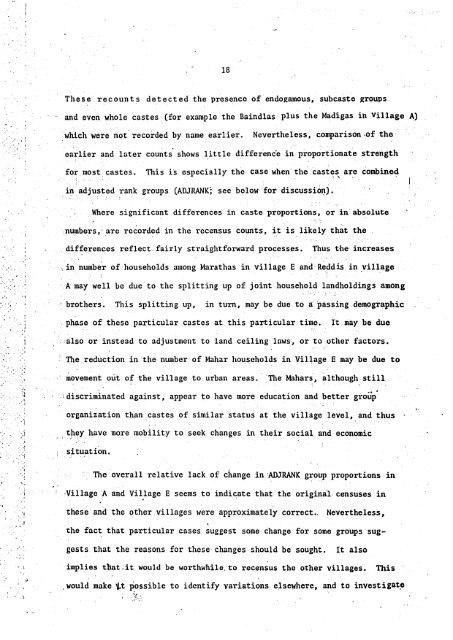A Guide to the Study of Social and Economic Groups and ... - icrisat
A Guide to the Study of Social and Economic Groups and ... - icrisat
A Guide to the Study of Social and Economic Groups and ... - icrisat
You also want an ePaper? Increase the reach of your titles
YUMPU automatically turns print PDFs into web optimized ePapers that Google loves.
18<br />
These recounts detected <strong>the</strong> presence <strong>of</strong> endogamous, subcas<strong>to</strong> groups<br />
- <strong>and</strong> even whole castes (for example <strong>the</strong> Baindlas plus <strong>the</strong> Madigas in village A)<br />
which were not recorded by name earlier. Never<strong>the</strong>less, comparison .<strong>of</strong> <strong>the</strong><br />
earlier <strong>and</strong> later counts shows little differenCe in proportionate strength<br />
for most castes. This is especially <strong>the</strong> case when <strong>the</strong> castes are combined<br />
in adjusted rank groups (ADJRANK; see below for discussion).<br />
Where significant differences in caste proportions, or in absolute<br />
numbers,. are recorded in <strong>the</strong> recensus counts, it is likely that <strong>the</strong><br />
differences reflect,fairly straightforward processes. Thus <strong>the</strong> increases<br />
in number <strong>of</strong> households among Marathas in village E <strong>and</strong>.Reddis in village<br />
A .<br />
may well be due <strong>to</strong> <strong>the</strong> splitting up <strong>of</strong> joint ,household l<strong>and</strong>holdings among<br />
bro<strong>the</strong>rs. This splitting up, in turn, may be due <strong>to</strong> a passing demographic<br />
:phase <strong>of</strong> <strong>the</strong>se particular castes at this particular time. It may be due<br />
also or instead <strong>to</strong> adjustment <strong>to</strong> l<strong>and</strong> ceiling laws, or <strong>to</strong> o<strong>the</strong>r fac<strong>to</strong>rs.<br />
The.reduction in <strong>the</strong> number <strong>of</strong> Mahar households in Village E may be due <strong>to</strong><br />
movement out <strong>of</strong> <strong>the</strong> village <strong>to</strong> urban areas. The Mahars, although still<br />
-discriminated against, appear <strong>to</strong> have more education <strong>and</strong> better groiii<br />
organization than castes <strong>of</strong> similar status at <strong>the</strong> village level, <strong>and</strong> thus •<br />
<strong>the</strong>y have more mobility <strong>to</strong> seek changes in <strong>the</strong>ir social <strong>and</strong> economic<br />
situation.<br />
The overall relative lack <strong>of</strong> change in ADJRANK group proportions in<br />
Village A <strong>and</strong> Village E seems <strong>to</strong> indicate that <strong>the</strong> original• censuses in<br />
<strong>the</strong>se <strong>and</strong> <strong>the</strong> o<strong>the</strong>r villages were approximately correct. Never<strong>the</strong>less,<br />
<strong>the</strong> fact that particular cases suggest some change for some groups suggests<br />
that <strong>the</strong> reasons for <strong>the</strong>se changes should be sought. It also<br />
implies that.it would be worthwhile, <strong>to</strong> recensus <strong>the</strong> o<strong>the</strong>r villages. This<br />
.would make it possible <strong>to</strong> identify variations elsewhere, <strong>and</strong> <strong>to</strong> investigate<br />
., •
















